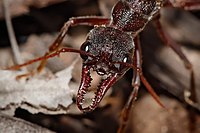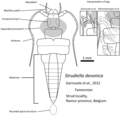The Insects Portal


Insects (from Latin insectum) are hexapod invertebrates of the class Insecta. They are the largest group within the arthropod phylum. Insects have a chitinous exoskeleton, a three-part body (head, thorax and abdomen), three pairs of jointed legs, compound eyes, and a pair of antennae. Insects are the most diverse group of animals, with more than a million described species; they represent more than half of all animal species. (Full article...)
Selected article -

Colony collapse disorder (CCD) is an abnormal phenomenon that occurs when the majority of worker bees in a honey bee colony disappear, leaving behind a queen, plenty of food, and a few nurse bees to care for the remaining immature bees. While such disappearances have occurred sporadically throughout the history of apiculture, and have been known by various names (including disappearing disease, spring dwindle, May disease, autumn collapse, and fall dwindle disease), the syndrome was renamed colony collapse disorder in early 2007 in conjunction with a drastic rise in reports of disappearances of western honey bee (Apis mellifera) colonies in North America. Beekeepers in most European countries had observed a similar phenomenon since 1998, especially in Southern and Western Europe; the Northern Ireland Assembly received reports of a decline greater than 50%. The phenomenon became more global when it affected some Asian and African countries as well. From 1990 to 2021, the United Nation’s FAO calculated that the worldwide number of honeybee colonies increased 47%, reaching 102 million.
Colony collapse disorder could cause significant economic losses because many agricultural crops worldwide depend on pollination by western honey bees. According to FAO, the total value of global crops pollinated by honey bees was estimated at nearly US$200 billion in 2005. In the United States, shortages of bees have increased the cost to farmers renting them for pollination services by up to 20%. Declining numbers of bees predate CCD by several decades, however: the US managed hive industry has been shrinking at a steady pace since 1961. (Full article...)Did you know -
- ... that the Australian moth Abantiades latipennis is well-adapted to surviving clearfelling and thrives in regrowth forests?
- ... that out of the described snakefly specimens from the Florissant Formation, the Raphidia funerata holotype is the most complete?
- ... that Ctenomorphodes chronus is an Australian stick insect that resembles an eucalyptus twig, and the female lays 3-mm elliptical eggs that resemble plant seeds?
- ... that when a Japanese honeybee hive is invaded by a giant hornet scout, the honeybees "bake" the hornet in a ball of about 500 bees?
- ... that Acanthoplus discoidalis is able to squirt haemolymph up to 30 centimetres (11.8 in) when attacked by predators?
List articles
Related portals
General images -
Selected image -

The yellow fever mosquito, Aedes aegypti (Diptera: Culicidae), is a mosquito that can spread the dengue fever, Chikungunya and yellow fever viruses, and other diseases. It can be recognized by white markings on legs and a marking in the form of a lyre on the thorax.
WikiProjects

Main WikiProject:
Related projects:
- WikiProject Arthropods
- WikiProject Spiders
- WikiProject Animals
- WikiProject Tree of Life
- WikiProject Biology
Daughter projects:
Tasks
 |
Here are some tasks awaiting attention:
|
Associated Wikimedia
The following Wikimedia Foundation sister projects provide more on this subject:
-
Commons
Free media repository -
Wikibooks
Free textbooks and manuals -
Wikidata
Free knowledge base -
Wikinews
Free-content news -
Wikiquote
Collection of quotations -
Wikisource
Free-content library -
Wikiversity
Free learning tools -
Wiktionary
Dictionary and thesaurus


















































